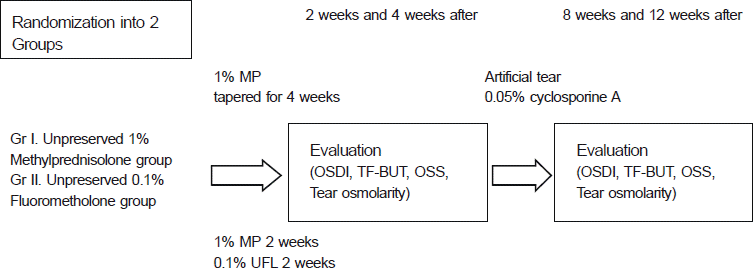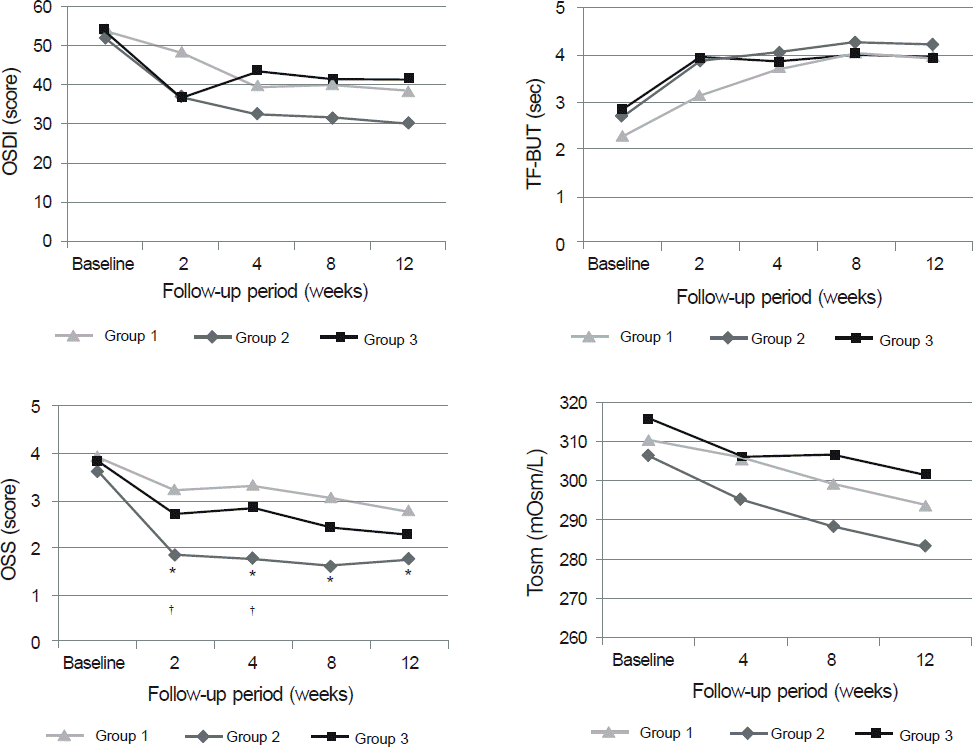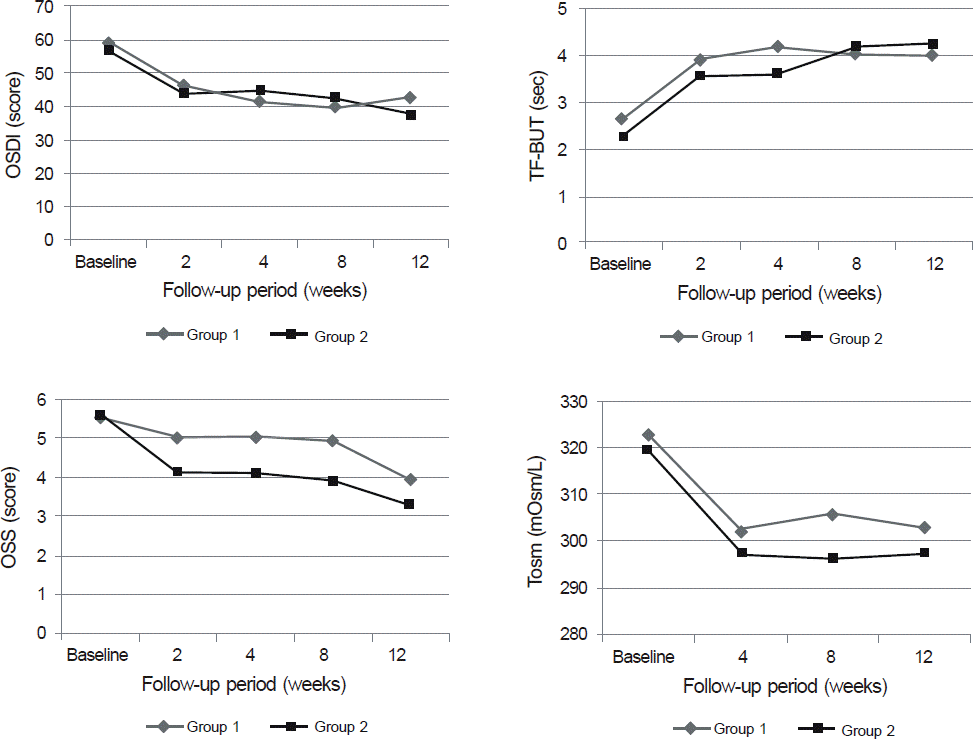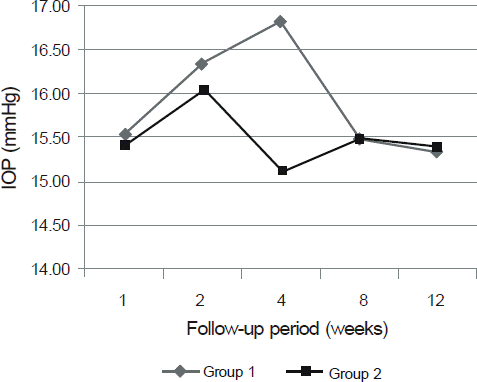Abstract
Purpose
To evaluate the efficacy and safety of topical unpreserved 0.1% fluorometholone (FML) ophthalmic solution in patients with dry eye syndrome.
Methods
Patients with mild to moderate dry eye syndrome were divided into the control group (Group I), topical unpreserved 0.1% FML group (Group II), and topical preserved 0.1% FML group (Group III). Intraocular pressure (IOP), Ocular Surface Disease Index (OSDI), tear film break-up time (TF-BUT), Oxford stain score (OSS), and tear osmolarity (Tosm) were evaluated at 2 weeks, 4 weeks, 8 weeks, and 12 weeks (Trial 1). Patients with severe dry eye syndrome were divided into 1% methylprednisolone (MP) group (Group I) and 0.1% unpreserved FML group (Group II). Same parameters were evaluated in both groups (Trial 2).
Go to : 
References
1. Brewitt H, Sistani F. Dry eye disease: the scale of the problem. Surv Ophthalmol. 2001; 45:199–202.
2. Pflugfelder SC, Tseng SC, Sanabria O, et al. Evaluation of subjective assessments and objective diagnostic tests for diagnosing tear-film disorders known to cause ocular irritation. Cornea. 1998; 17:38–56.

3. Stern ME, Beuerman RW, Fox RI, et al. The pathology of dry eye: the interaction between the ocular surface and lacrimal glands. Cornea. 1998; 17:584–9.
5. Dana M, Hamrah P. Role of immunity and inflammation in corneal and ocular surface disease associated with dry eye. Adv Exp Med Biol. 2002; 506:729–38.

6. Barton K, Monroy DC, Nava A, Pflugfelder SC. Inflammatory cytokines in the tears of patients with ocular rosacea. Ophthalmology. 1997; 104:1868–74.

7. Pflugfelder SC, Jones D, Ji Z, et al. Altered cytokine balance in the tear fluid and conjunctiva of patients with Sjögren's syndrome keratoconjunctivitis sicca. Curr Eye Res. 1999; 19:201–11.

8. Tishler M, Yaron I, Geyer O, et al. Elevated tear interleukin-6 levels in patients with Sjögren syndrome. Ophthalmology. 1998; 105:2327–9.

9. Yoon KC, Jeong IY, Park YG, Yang SY. Interleukin-6 and tumor necrosis factor-alpha levels in tears of patients with dry eye syndrome. Cornea. 2007; 26:431–7.
10. Stevenson D, Tauber J, Reis BL. Efficacy and safety of cyclosporin A ophthalmic emulsion in the treatment of moderate-to-severe dry eye disease: a dose-ranging, randomized trial. The Cyclosporin A Phase 2 Study Group. Ophthalmology. 2000; 107:967–74.
11. Power WJ, Mullaney P, Farrell M, Collum LM. Effect of topical cyclosporin A on conjunctival T cells in patients with secondary Sjögren's syndrome. Cornea. 1993; 12:507–11.

12. Borel JF, Baumann G, Chapman I, et al. In vivo Pharmacological effects of ciclosporin and some analogues. Adv Pharmacol. 1996; 35:115–246.

13. Marsh P, Pflugfelder SC. Topical nonpreserved methylprednisolone therapy for keratoconjunctivitis sicca in Sjögren's syndrome. Ophthalmology. 1999; 106:811–6.
14. Hong S, Kim T, Chung SH, et al. Recurrence after topical non-preserved methylprednisolone therapy for keratoconjunctivitis sicca in Sjögren's syndrome. J Ocul Pharmacol Ther. 2007; 23:78–82.

15. Avunduk AM, Avunduk MC, Varnell ED, Kaufman HE. The comparison of efficacies of topical corticosteroids and nonsteroidal anti-inflammatory drops on dry eye patients: a clinical and immunocytochemical study. Am J Ophthalmol. 2003; 136:593–602.

16. Burstein NL. Preservative cytotoxic threshold for benzalkonium chloride and chlorhexidine digluconate in cat and rabbit corneas. Invest Ophthalmol Vis Sci. 1980; 19:308–13.
17. Burstein NL. Corneal cytotoxicity of topically applied drugs, vehicles and preservatives. Surv Ophthalmol. 1980; 25:15–30.

18. Wilson SE, Stulting RD. Agreement of physician treatment practices with the international task force guidelines for diagnosis and treatment of dry eye disease. Cornea. 2007; 26:284–9.

19. The definition and classification of dry eye disease: repot of the Definition and Classification Subcommittee of the International Dry Eye Workshop (2007). Ocul Surf. 2007; 5:75–92.
20. Kim WJ, Kim HS, Kim MS. Current trends in the recognition and treatment of dry eye: a survey of ophthalmologists. J Korean Ophthalmol Soc. 2007; 48:1614–22.

21. Lee JS, Jung DY, Oum BS, Kim CD. Cytotoxicity of benzalkonium chloride on the corneal epithelial cell of rabbit. J Korean Ophthalmol Soc. 1998; 39:1326–33.
22. Epstein SP, Chen D, Asbell PA. Evaluation of biomarkers of inflammation in response to benzalkonium chloride on corneal and conjunctival epithelial cells. J Ocul Pharmacol Ther. 2009; 25:415–24.

23. Epstein SP, Ahdoot M, Marcus E, Asbell PA. Comparative toxicity of preservatives on immortalized corneal and conjunctival epithelial cells. J Ocul Pharmacol Ther. 2009; 25:113–9.

24. Lee JK, Ryu YH. The effect of antiglaucoma medication on cultured human conjunctival epithelial cells. J Korean Ophthalmol Soc. 2006; 47:1811–8.
25. Pisella PJ, Debbasch C, Hamard P, et al. Conjunctival proinflammatory and proapoptotic effects of latanoprost and preserved and unpreserved timolol: an ex vivo and in vitro study. Invest Ophthalmol Vis Sci. 2004; 45:1360–8.

26. de Jong C, Stolwijk T, Kuppens E, et al. Topical timolol with and without benzalkonium chloride: epithelial permeability and autofluorescence of the cornea in glaucoma. Graefes Arch Clin Exp Ophthalmol. 1994; 232:221–4.

27. De Saint Jean M, Brignole F, Bringuier AF, et al. Effects of benzalkonium chloride on growth and survival of Chang conjunctival cells. Invest Ophthalmol Vis Sci. 1999; 40:619–30.
28. Jaenen N, Baudouin C, Pouliquen P, et al. Ocular symptoms and signs with preserved and preservative-free glaucoma medications. Eur J Ophthalmol. 2007; 17:341–9.

29. Marsh P, Pflugfelder SC. Topical nonpreserved methylprednisolone therapy for keratoconjunctivitis sicca in Sjögren syndrome. Ophthalmology. 1999; 106:811–6.

30. Albert DM, Miller JW, Azar DT, et al. Albert & Jakobiec's principles and practice of ophthalmology. 3rd ed. v. 1. Philadelphia: Elsevier;2008. p. 249–58.
Go to : 
 | Figure 1.Trial 1 study flow chart. OSDI = ocular surface disease index; TF-BUT = tear film break-up time; OSS = oxford stain score. |
 | Figure 2.Trial 2 study flow chart. UFL = unpreserved 0.1% Fluorometholone; MP = Methylprednisolone; OSDI = ocular surface disease index; TF-BUT = tear film break-up time; OSS = oxford stain score. |
 | Figure 3.Changes in the tear film and ocular surface parameters in Trial 1. OSS scores of Group II are lower than other groups at 2 weeks and 4 weeks (p < 0.05). The other parameters were not significant between the 3 groups. Pairwise comparison p-values are represented by ∗significant (p < 0.05) difference between control group and UFL group; †significant difference between UFL group and PFL group. UFL = unpreserved 0.1% fluorometholone; PFL = preserved 0.1% fluorometholone; OSDI = ocular surface disease index; TF-BUT = tear film break-up time; OSS = oxford stain score; Tosm = tear osmolarity. |
 | Figure 4.Changes in the tear film and ocular surface parameters in Trial 2. There were no significant differences in all parameters between the 2 groups. UFL = unpreserved 0.1% fluorometholone; MP = methylprednisolone; OSDI = ocular surface disease index; TF-BUT = tear film break-up time; OSS = oxford stain score; Tosm = tear osmolarity. |
 | Figure 5.Changes in the intraocular pressure in Trial 2. Group 1 showed higher mean IOP at 4 weeks than group 2. But the value was not statistically significant (p = 0.077). UFL = un-preserved 0.1% fluorometholone; M P = methylprednisolone; IOP = intraocular pressure. |
Table 1.
Clinical characteristics and tear film and ocular surface parameters of the patients
| Group | Trial 1 | p-value | Trial 2 | p-value | |||
|---|---|---|---|---|---|---|---|
| Group 1 (n = 19) | Group 2 (n = 25) | Group 3 (n = 14) | Group 1 (n = 22) | Group 2 (n = 26) | |||
| Age (mean ± SD, year) | 50.0 ± 8.23 | 51.66 ± 8.38 | 51.1 ± 2.95 | 0.752† | 50.0 ± 9.32 | 48.0 ± 10.42 | 0.604‡ |
| Sex, n | 0.075∗ | 0.516∗ | |||||
| Male | 2 | 3 | 0 | 2 | 4 | ||
| Female | 17 | 23 | 14 | 20 | 22 | ||
| OSDI (mean ± SD) | 53.21 ± 19.21 | 51.71 ± 19.76 | 54.15 ± 18.87 | 0.926† | 60.15 ± 28.07 | 59.15 ± 19.27 | 0.605‡ |
| TF-BUT (mean ± SD, sec) | 2.82 ± 1.24 | 2.72 ± 0.84 | 2.86 ± 1.51 | 0.927† | 2.65 ± 1.38 | 2.44 ± 1.42 | 0.504‡ |
| OSS (mean ± SD, score) | 3.93 ± 1.38 | 3.64 ± 1.68 | 3.86 ± 1.56 | 0.838† | 5.55 ± 3.25 | 5.6 ± 2.53 | 0.836‡ |
| Tosm (mean ± SD, mosm) | 310.64 ± 14.49 | 310.83 ± 15.11 | 315.71 ± 29.28 | 0.414† | 322.57 ± 13.29 | 319.62 ± 16.97 | 0.392‡ |
Table 2.
Changes in the tear film and ocular surface parameters in Trial 1
| Group I | Group II | Group III | p-value | |
|---|---|---|---|---|
| OSDI (mean ± SD) | ||||
| 2 weeks | 48.42 ± 19.57 | 36.69 ± 13.14 | 36.23 ± 18.28 | 0.056 |
| 4 weeks | 40.09 ± 14.23 | 32.59 ± 15.22 | 43.36 ± 11.87 | 0.058 |
| 8 weeks | 40.53 ± 17.21 | 31.53 ± 11.30 | 41.37 ± 14.45 | 0.059 |
| 12 weeks | 38.54 ± 16.06 | 30.23 ± 13.52 | 41.64 ± 16.90 | 0.058 |
| TF-BUT (mean ± SD, sec) | ||||
| 2 weeks | 3.17 ± 0.88 | 3.91 ± 1.31 | 3.93 ± 1.21 | 0.104 |
| 4 weeks | 3.69 ± 1.45 | 4.09 ± 1.60 | 3.85 ± 1.10 | 0.689 |
| 8 weeks | 4.06 ± 1.39 | 4.26 ± 1.41 | 4.00 ± 1.04 | 0.829 |
| 12 weeks | 4.00 ± 1.41 | 4.21 ± 1.44 | 3.92 ± 1.07 | 0.816 |
| OSS (mean ± SD, score) | ||||
| 2 weeks | 3.25 ± 1.73 | 1.84 ± 0.62 | 2.71 ± 0.47 | <0.001∗,† |
| 4 weeks | 3.34 ± 1.54 | 1.76 ± 0.83 | 2.86 ± 1.10 | <0.001∗,† |
| 8 weeks | 3.07 ± 1.49 | 1.60 ± 1.00 | 2.43 ± 1.28 | 0.002∗ |
| 12 weeks | 2.79 ± 1.31 | 1.76 ± 1.10 | 2.29 ± 0.91 | 0.026∗ |
| Tosm (mean ± SD, mosm) | ||||
| 4 weeks | 306 ± 14.40 | 295.2 ± 19.11 | 306.67 ± 12.70 | 0.382 |
| 8 weeks | 299.6 ± 14.36 | 288.33 ± 7.64 | 306.75 ± 15.22 | 0.254 |
| 12 weeks | 294.0 ± 10.98 | 283.33 ± 5.77 | 301.50 ± 6.36 | 0.108 |
Table 3.
Abnormal response to eyedrops
| UFL | PFL | |
|---|---|---|
| FB sensation | 1 | 1 |
| Stinging/Burning sensation | 1 | 1 |
| Pain/Discomfort | 0 | 3 |
| Tearing | 0 | 0 |
| Itching | 0 | 0 |
| 8% (2/22) | 35.7% (5/14) |
Table 4.
Changes in the tear film and ocular surface parameters in Trial 2




 PDF
PDF ePub
ePub Citation
Citation Print
Print


 XML Download
XML Download